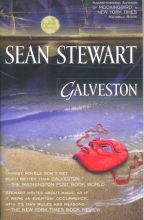Galveston
Sean Stewart
Ace Books / Penguin Putnam
US Mass Market Paperback
ISBN: 0 441 00996 4
Pages: 456; $7.99
Date Reviewed: 12th March 2003
Reviewed by: Serena Trowbridge © 2003

REFERENCES
COLUMNS
|
|
|
GalvestonSean StewartAce Books / Penguin PutnamUS Mass Market PaperbackISBN: 0 441 00996 4Pages: 456; $7.99Date Reviewed: 12th March 2003Reviewed by: Serena Trowbridge © 2003 |
|
|
REFERENCES |
COLUMNS |
Like Stewart's other books, this novel is evocatively set in Texas, in Galveston, a city unfortunate enough to have suffered two floods, of water in 1900 and of magic in 2004. During Mardi Gras in 2004, something goes horribly wrong, and the magic that is a part of the festival is released and the town is partly taken over by it. There is no doubt that Galveston itself is the hero of this novel; the streets and buildings are lovingly recreated and the book displays a fine sense of place. The part of Galveston that has been immersed in Mardi Gras is a twenty-four hour party town, ruled by the wise but evil god Momus. The part that remains civilized (albeit primitive, without medicine or provisions) is kept in control by two strong women, Jane, who is a politician, and Odessa, who understands and holds back the magic. Jane's daughter Sloane moves between these worlds as she uses Odessa's magic to form a mask that allows her to become a part of the Mardi Gras in order to talk to Momus (who is, confusingly, her father) and persuade him to save her mother, who is dying, and thus save the town from being taken over by dark forces of magic which threaten to submerge them entirely.
The other central character is Josh, an apothecary with contempt for the people around him and a secret passion for Sloane. He and his friend, Ham, are accused of a crime they did not commit and cast out into a desert straight out of a 1950s sci-fi film and even less convincing, although I chose to see it as a touch of parody. Galveston is the story of their fight for survival, in the world we know gone badly wrong.
The basic premise of the story is interesting, particularly if read as an allegorical tale: the attempts to suppress the magic of Mardi Gras are the attempts made by society and individuals to repress what we don't understand and what we see as primitive, and therefore negative, cultural and social urges in our collective subconsciousness. The use of magic is seen as ambivalent: both useful and dangerous, and its possibilities are explored in detail here. The twisting of the world we know into an alternate magical reality with its dark forces and bright exterior is well portrayed.
This is a book about magical transformations, and like all good magicians, Sean Stewart leaves us bewildered by the shape-changing of his creations. Unfortunately this is not such a successful tactic for an author, although as an allegory the book has many redeeming features. However the characters, particularly the women, could be more developed, since they appear somewhat unrealistic and one-dimensional. My particular complaint, however, is that strong, powerful, attractive women in fantasy novels are frequently given such dowdy clothes to wear by their creator.